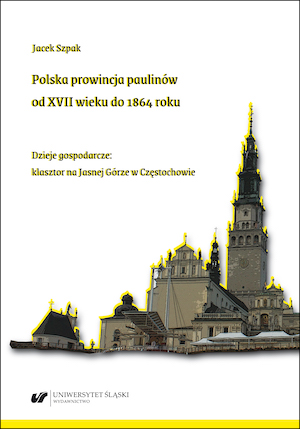Polska prowincja paulinów od XVII wieku do 1864 roku. Dzieje gospodarcze: klasztor na Jasnej Górze w Częstochowie
The Polish Province of the Paulines from the 17th century to 1864. Economic history: the Pauline Monastery of Jasna Góra in Częstochowa
Author(s): Jacek Szpak
Subject(s): History, Cultural history, Social history, Modern Age, 19th Century
Published by: Wydawnictwo Uniwersytetu Śląskiego
Keywords: Jasna Góra; Pauline Fathers; the Catholic Church;economy;
Summary/Abstract: The Pauline Monastery in Jasna Góra was founded by Prince Władysław Opolczyk in 1382. Within a short time, Jasna Góra became a popular place of pilgrimage for the faithful who came to worship the Blessed Mother depicted in the painting in the monastery chapel. Because of the development of the pilgrimage phenomenon, the sanctuary and the monastery quickly rose to fame, which brought about numerous religious and economic privileges. In order to undertake economic activity, the monastery and sanctuary had to have economic foundations. The most significant role in maintaining the institution was performed by the agricultural estates received by the Paulines from the founders and donors. However, the monks themselves also bought land estates or were involved in settlement activities. The agricultural estates owned by the Jasna Góra monastery were divided into formations called klucz. The Paulines of Jasna Góra were also engaged in farming activities in the estates that were in their possession temporarily — given to them as a pledge, i.e. guarantee of financial loans. The Paulines of Jasna Góra also received two items of klucz formations from the endowment by the Sejm of the Republic of Poland. These were the Kłobuck and Brzeźnica starostship (district of starostwo), which constituted the financial base for the maintaining of the Jasna Góra fortress. In total, the monks were in possession of 4 cities and 83 villages and other settlement units. It must be remembered, however, that not all the properties were owned by the Pauline monks at the same time. The largest amount of properties was under the ownership of the Paulines in the 18th century. [part of the summary]
Series: Historia
- E-ISBN-13: 978-83-226-3712-8
- Print-ISBN-13: 978-83-226-3711-1
- Page Count: 646
- Publication Year: 2020
- Language: Polish
- eBook-PDF
- Table of Content
- Introduction

